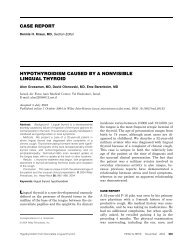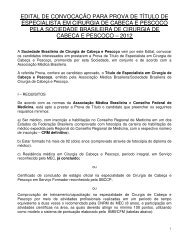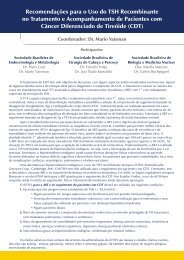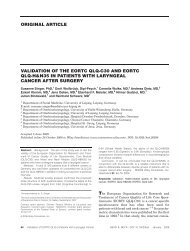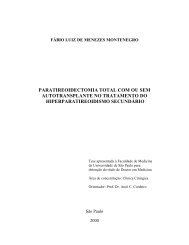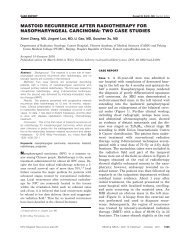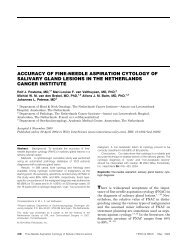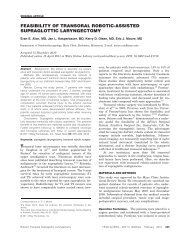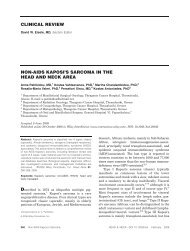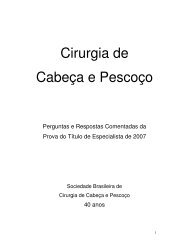cribriform-morular variant of papillary thyroid carcinoma
cribriform-morular variant of papillary thyroid carcinoma
cribriform-morular variant of papillary thyroid carcinoma
- No tags were found...
You also want an ePaper? Increase the reach of your titles
YUMPU automatically turns print PDFs into web optimized ePapers that Google loves.
gist. Her family history was notable for memberswith both hyper<strong>thyroid</strong>ism and hypo<strong>thyroid</strong>ism; amaternal grandmother had colonic polyps at theage <strong>of</strong> 70.On physical examination, she had a 2 3 2 cm,firm, mobile nodule <strong>of</strong> the left <strong>thyroid</strong> lobe. No palpablecervical or supraclavicular lymphadenopathywas found. Ultrasound demonstrated a 2.1-cmmass in the left <strong>thyroid</strong> lobe as well as a 5-mmnodule in the isthmus. A <strong>thyroid</strong> scan revealed acold left <strong>thyroid</strong> nodule. A fine-needle aspiration(FNA) biopsy specimen demonstrated cells suspiciousfor follicular neoplasia. Thyroid functiontests were normal. On review <strong>of</strong> her disease by ourinstitution, concern was raised for a PTC. Thepatient underwent a total <strong>thyroid</strong>ectomy. Postoperatively,colonoscopy revealed a normal colonwithout polyposis.The final pathology report revealed a 2.05-cmPTC <strong>of</strong> the left <strong>thyroid</strong> lobe. The tumor was well differentiatedand did not have capsular or vascularinvasion, extra<strong>thyroid</strong>al extension, or multicentricity.Of note, the tumor was a ‘<strong>cribriform</strong>-<strong>morular</strong><strong>variant</strong>’ <strong>of</strong> PTC and demonstrated intermingled <strong>cribriform</strong>,follicular, <strong>papillary</strong>, trabecular, and <strong>morular</strong>architecture (Figure 1). The remainder <strong>of</strong> the<strong>thyroid</strong> had nodular hyperplasia. Immunohistochemically,the tumor stained positively for thyroglobulinand cytokeratin 7 and was negative for cytokeratin20, estrogen receptor, and progesteronereceptor. No nuclear staining with beta-cateninwas found.Patient 2. A 34-year-old woman with a history <strong>of</strong>FAP was found to have an enlarged <strong>thyroid</strong> glandon routine physical examination. In 1992, thepatient had undergone a proctocolectomy and excision<strong>of</strong> an abdominal wall desmoid tumor; desmoidsoccur in up to 10% <strong>of</strong> FAP patients and area manifestation <strong>of</strong> Gardner’s syndrome. 5 The desmoidwas also treated with adjuvant radiation. In1998, the desmoid tumor recurred in the pelvisand was treated with chemotherapy. In 1999, thepatient was diagnosed with duodenal tubularadenomas. Her paternal grandmother was the indexcase <strong>of</strong> FAP.Physical examination revealed a 2-cm, smoothdominant nodule <strong>of</strong> the right <strong>thyroid</strong> lobe andvague nodularity <strong>of</strong> the left <strong>thyroid</strong> lobe. Examination<strong>of</strong> the larynx revealed normal mobile vocalcords. Ultrasound demonstrated three nodules inthe right lobe and two smaller nodules in the leftFIGURE 1. The variegated histologic appearance <strong>of</strong> the <strong>cribriform</strong>-<strong>morular</strong> <strong>variant</strong>. This sporadic case (patient 1) displays <strong>cribriform</strong>(upper left), <strong>papillary</strong> (upper right), and hyalinized areas (lower left). Interspersed islands <strong>of</strong> squamoid and spindle cells (mainly spindlecells in this case) known as morules were also seen (delineated by the arrows; lower right). [Color figure can be viewed in the onlineissue, which is available at www.interscience.wiley.com.]472 Cribriform-Morular Variant <strong>of</strong> Papillary Cancer HEAD & NECK—DOI 10.1002/hed May 2006



